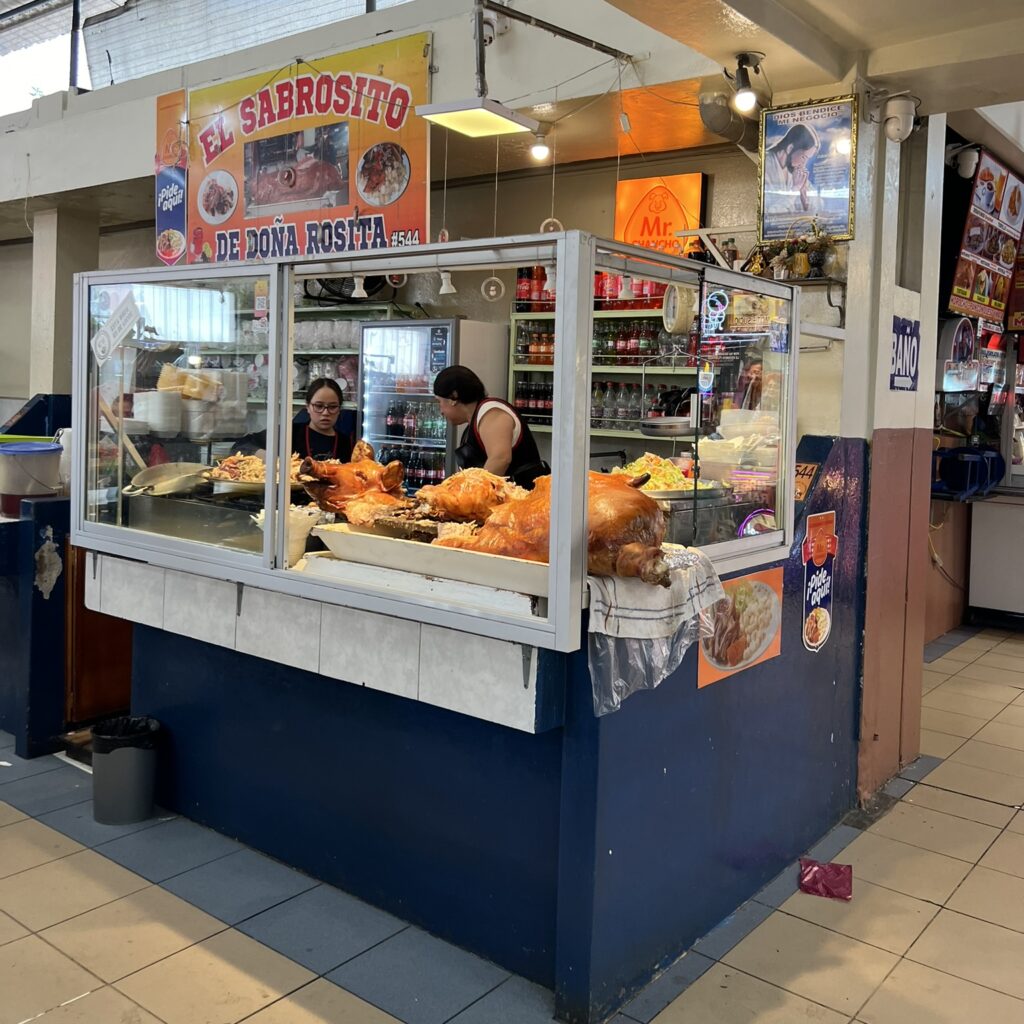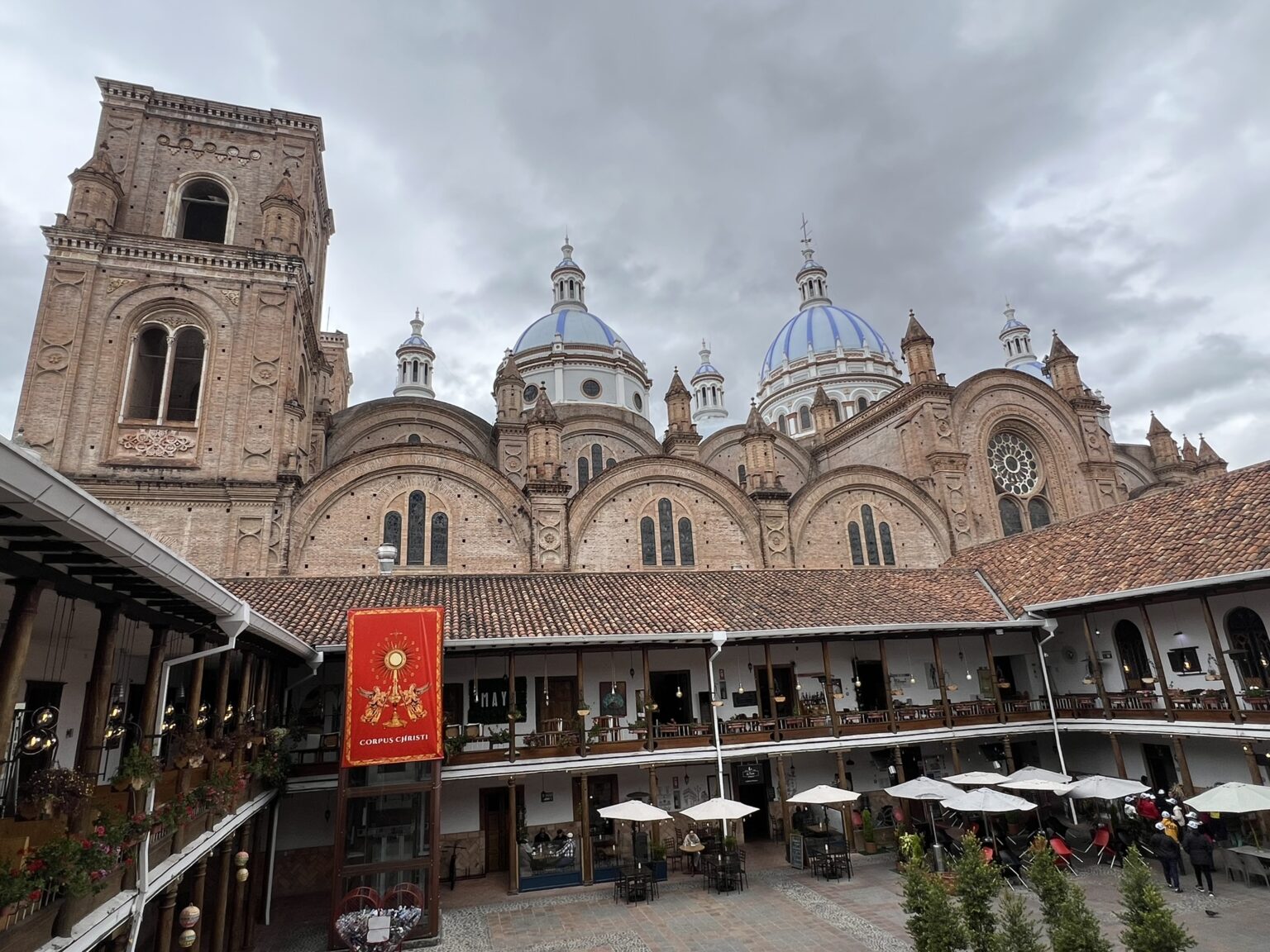Cuenca, Ecuador’s third largest city, is known as the Athens of the Andes because of its cultural significance. We spent the week visiting Cuenca and exploring its UNESCO Historic Center, Cajas National Park, and surrounding cultural areas.
Best Thing I Ate This Week
Plato Hornado de Chancho at El Sabrosito de Dona Rosita
Located in the Historic Center of Cuenca is Mercado 10 de Agosto, one of Cuenca’s most popular markets. In this market, you can find fresh produce, local products such as coffee or chocolate, herbal remedies, and so much more. There is also a section of the market that contains restaurants with some that focus on lunch specialties, others that serve breakfast dishes, and a few that focus on regional cuisine. During our walking tour of Cuenca, our guide recommended the market as a great place to come for lunch and suggested we go back to try Hornado de Chancho, a favorite regional dish from Cuenca.

Hornado translates to oven in English and the process of preparing this meal consists of cooking an entire pig in an oven. The pig is slow roasted and cooked in a marinade, both of which result in the meat being incredibly flavorful and tender. The skin of the pig is usually crispy, and the plate is generally served with a combination of the tender interior meat and crunchy exterior. Most restaurants display the full pig to show that it is fresh, and the best restaurants only serve the pig that was prepared the day prior.

We chose to go to El Sabrosito de Dona Rosita because of the recommendation of our guide, and, when we arrived, all of the tables were filled with locals enjoying their plates of Hornado de Chanco. A few seats cleared up as the diners quickly devoured their plates, and we were able to start enjoying ours. The meat was cooked to perfection and so delicious that it made me want to have another before leaving Cuenca.

An Interesting Fact I Learned
Cañari Culture is an Important Part of the Cuenca Region
Prior to the arrival of the Incas in the 1400s, the Cañari people lived in the Cuenca region of Ecuador. They successfully thwarted the Inca attempts to conquer their land a few times but the Incas persisted, eventually proposing a grand marriage between the royal families of the two civilizations. The Cañari people were experts in astrology and worshiped the moon. One of their most important Moon Temples was located at Ingapirca. When the union with the Incas occurred, they created an extraordinary Sun Temple at Ingapirca to merge the two cultures. Unlike in many other areas that the Incas took over, they did not build on top of the existing Cañari temples because they wanted to respect their important union. Ingapirca became the second most important site of the Inca Empire outside of the capital of Cuzco. Today, a portion of the enormous Ingapirca ruins has been excavated, and we were able to visit with a guide of Cañari descent who shared more about this incredible history. We learned that if the entire site was excavated, it would be significantly larger than Machu Picchu which was remarkable because just the portion we visited was already very impressive.

In addition to the ancient Cañari culture, many people still carry on their heritage today despite the Inca and Spanish conquests. On the way to Ingapirca, we were able to stop at the modern day town of Cañar, which hosts a large market every Sunday. People from the surrounding Andes communities come to sell their goods and shop for products for the week. Many of the women continue to put on their best traditional dresses and hats. Our guide, Luis, was able to identify what community they came from based on the design of the hat and dresses. He let us know that as the world modernizes people more frequently are turning away from this type of dress and leaving their traditions behind. This process started when men ventured out from the communities to find work. Now, the younger generation of women are doing the same. Many of the older generations still run organic farms that supply the majority of the delicious food to the country, but their kids are leaving to find work in the larger cities or many times other countries. Luis is uncertain what will happen to these farms in the future when there is no one to work them and worries the rich culture will not continue with the next generations. He remarked that when he was a kid the Cañar Sunday market used to be overflowing with people celebrating the old traditions but now it has become significantly less prominent only a few decades later.


My Travel Tip of the Week
Go Hiking in Cajas National Park while in Cuenca
Located a little under an hour drive from the Historic Center of Cuenca is the Cajas National Park, a bio-diverse wetland comprising 786 sites of water concentration. There are public buses that can drop you off in the park on the way to Guayaquil, but the most comfortable way to explore the national park is with a guided tour or driving yourself to the parking lot at Cajas National Park Visitor Center. We started our day in the national park by arriving early and checking in to El Refugio next to the parking lot. The weather was not the best but significantly better than the experience we had in Cotopaxi National Park. It was only a slight drizzle and the visibility was enough to see everything in the surrounding area but not the peaks above.

We did a moderate hike around Laguna Toreadora where we were exposed to the unique flora of this high altitude wetland. Given the rainy conditions, we saw some unique birds and other small animals on our walk, which was a nice surprise. A small part of our walk included a portion of an Inca trail, and we learned that more strenuous trails through the center of the park follow the trail more extensively (Sendero 7). We had a peaceful walk around Laguna Toreadora and the landscapes felt like being in a Lord of the Rings movie. It would have been amazing if it was a clear day, but under these conditions we were still able to enjoy the park. If the weather had been better we may have done the nearby Sendero 2 to get more exposure to the peaks above but the visibility wasn’t even good enough to go to the famous Mirador 3 Cruces which is known for some of the best views in the park.

After an early morning hike around Laguna Toreadora we continued our day in Cajas National Park at a lower elevation and did another small walk around Sendero Llaviucu. Since we were lower down, the weather was much better and the rain stopped completely. Part of the trail passed through a beautiful pasture where wild horses and llamas grazed. We also learned that an industrial company tried to build on this land but advocates were able to turn the area into Cajas National Park in the 1990s. Today the initial building structures from that company still stand but it was a big benefit to the community that the construction was stopped. Two of Cuenca’s primary rivers (Tomebamba and Yanuncay) start in the Cajas National Park and, because of the conservation efforts, the city has potable water today. Even though we didn’t have the best weather, it was still a great trip out of the city to experience a new natural environment. I could only imagine how great extensive hiking in the park would be in better conditions.

My Additional Anecdote This Week
Cuenca is a Beautiful City with Kind People
Anyone that we met who had visited Cuenca spoke highly of the city regardless if they were Ecuadorians or tourists. It is known for its architecture, culture, arts, sciences, and literature. Today, Cuenca is one of the safest cities in Latin America and it is so popular with expats that an entire neighborhood in the city is known as Gringoland, where many foreigners have moved full or part time. Although we did not spend time in Gringoland while in Cuenca, we explored the most popular areas of the city and now understand why people speak so highly of it.

Our introduction to the city was with a walking tour through the UNESCO Historic Center. The most memorable part of the walk was around Parque Calderon, which has the famous blue domed La Catedral de la Inmaculada Concepción de Cuenca among other historic buildings. One could spend hours wandering the well preserved streets that contain other historic buildings, churches, and plazas, which themselves make the city worth a visit.
However, there is more to do in Cuenca than visit just the old town. Museo Pumapungo is a great free museum that contains exhibits highlighting the native Ecuadorian cultures and displays some of the pre-Hispanic ruins in a park. The museum is very informative about the different traditions of the various cultures of Ecuador. Most of the displays are in Spanish but the artifacts and imagery still make it a meaningful stop if you can not read them. Another great museum is Homero Ortega Hats. It explains the history behind the famous Panama Hats, also known as paja toquilla, which are originally from the native population of Ecuador. The museum also shares how their family business has been producing these hats with the utmost quality for over 5 generations. Not only can you visit the museum but you can also watch the production process on site and even purchase a hat of your own to bring or ship home, as many famous celebrities have done.

Beyond these great museums, there are also some fun outdoor activities around the city such as walking along Rio Tomebamba. On your walk you will pass by restaurants and bars with views of the river and there are many places to picnic along the banks. Another outdoor highlight of Cuenca is Mirador Turi, an amazing viewpoint of the city that has a few fun attractions and restaurants nearby. You can walk out onto Puente de Cristal for even better views of the city or go to Parque Extremo Turi for adventure activities overlooking Cuenca below.
Besides being a great place to visit, the people from Cuenca made it a very welcoming place. Our host, guides, restaurant workers, and shop owners went out of their way to make us feel welcome. They always asked more about our visit, offered to help with anything that we needed during our stay, and shared their favorite things about Cuenca. One of the biggest surprises was meeting up with some of my former co-worker’s family members to end our time in Cuenca. They offered to spend two days with us going to Mirador Turi and eating traditional Cuenca food together. It was such a fun experience seeing Cuenca from a local perspective and being able to share in traditional meals together. It was so nice of them to make time for us in their busy life schedules on short notice, and our meals together of encebollado (a stew with fish and avocado) and cuy (guinea pig) were great ways to end our time in Cuenca.


